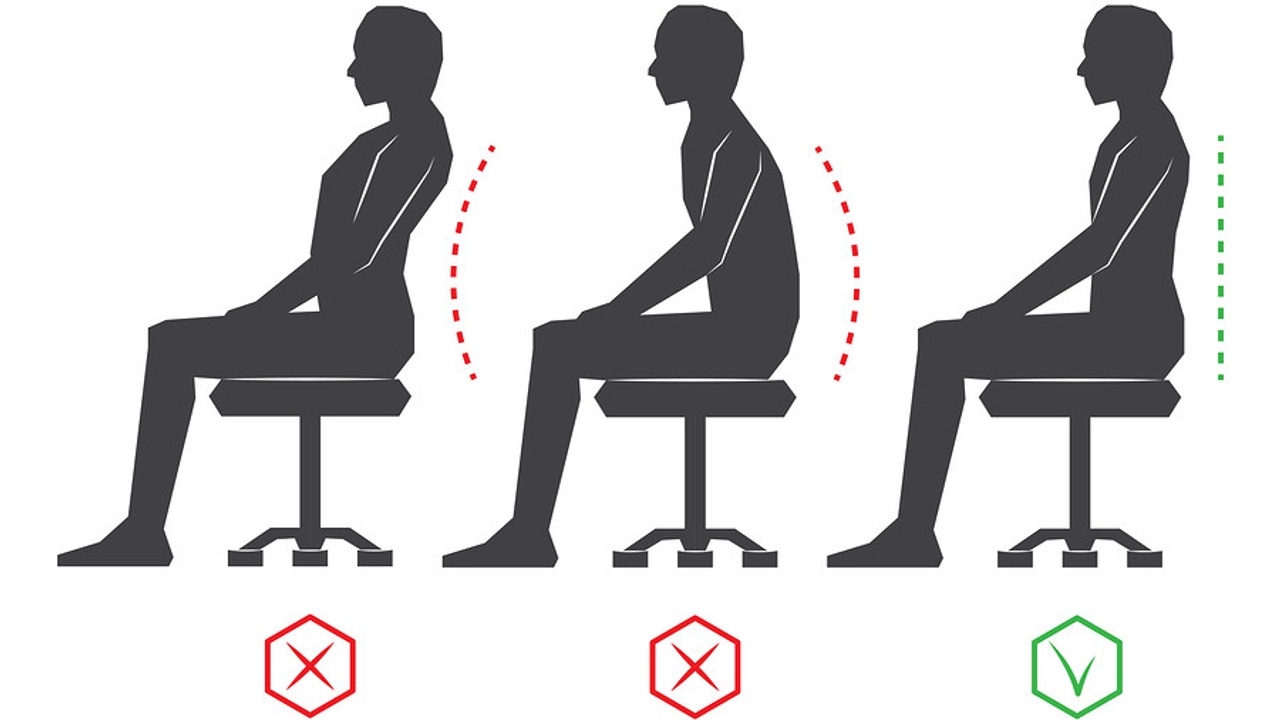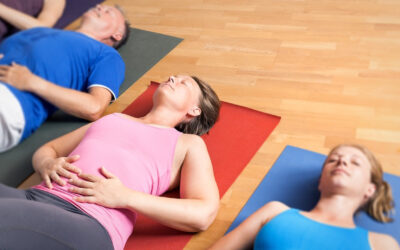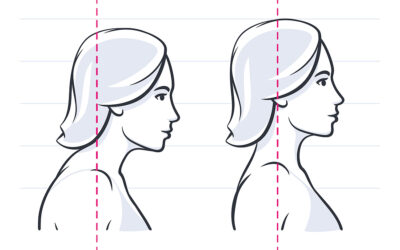This is the second blog entry in a series on sitting health.
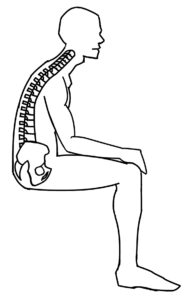
Look at the left side of the image. Can you see the “C”? This “C” posture is a posture of pain and dysfunction. Unfortunately, it is also very common. In fact, it’s the most frequently assumed position that many workers take. When I conducted ergonomic evaluations, a large percentage of the corporate employees I assisted had a “C” posture. And yes, they had pain.
The Biomechanics of a Painful Sitting Posture
In the illustration, notice how the arrow at the hips points toward the back. This means that there is an imbalance between the musculature on the front and back of the body. As the head moves forward and the shoulders and upper back round towards the computer, what is stopping us from taking a head dive into our keyboard? A strong pull in the opposite direction from the hip flexors at the other end of the spine.
In the “C” sitting position, the flexors, muscles on the front of the body, fully activate and pull down with great force to keep the upper body from falling forward. These muscles are tight and short. The extensors, muscles in the back of the body, are elongated. Because of this, they lose function and become weak from lack of stimulation. These muscles are tight and long.
if you look at the excessive strain on the upper back, neck and shoulder muscles in this “C” posture, is it any wonder why these areas are full of knots and painful? Without assistance from the spine, all of these muscles activate to keep the head upright. The forward head position restricts oxygen flow. This contribues to eye strain and headaches. The lower back, which is now overly lengthened from the flexed hip position, grows tight. In some cases, it is stuck so much that it can’t extend and move into a neutral position, even when standing.
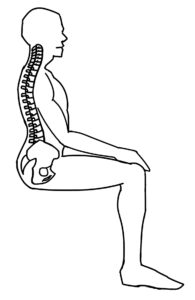 A Pain Free Sitting Posture
A Pain Free Sitting Posture
Now look at the image on the right. Here, you can see the spine in its natural and strong “S” posture. In this position, the body rests on the bones. Also, there is balance between the flexor and extensor muscles. And, the hips are in a neutral position. (The arrow is pointing up.) When the body is in balance the muscle are in their natural, relaxed position without stress and pain.
When we sit, we only have four of our eight load-bearing joints keeping us erect. These are the shoulders and hips. The position of these structures, along with the curve of the spine, work as a unit to dictate our posture. Additionally, our pelvis provides the foundation of our sitting posture. Often called the second brain of the body, the pelvis has two roles. First, it supports the upper body. And second, it generates movement.
When we sit, we focus on the pelvis in order to change our vertical alignment. We should not focus on the shoulders. Of course, our immediate reaction when someone says, “Sit up straight!” is to pull our shoulders back! However, we cannot maintain this posture very long without support from the pelvis below. So, instead of pulling your shoulders back to straighten up, roll your pelvis forward. Then, notice how the upper body automatically realigns.
in order to keep your body in the “S” sitting posture, you must be flexible and strong. Your hip flexors must be limber enough to extend from a flexed position and strong enough to hold your pelvis in alignment. Also, your chest must be open enough to allow the shoulders to move back towards the spine. Finally, your back musculature must be tone enough to hold the position. My next blog,
Get Fit to Sit – 5 Exercises for Better Desk Posture, gives you the tools you need for Pain Free Sitting.
Reference and Images: Pain Free at Your PC by Pete Egoscue with Roger Gittines
 Look at the left side of the image. Can you see the “C”? This “C” posture is a posture of pain and dysfunction. Unfortunately, it is also very common. In fact, it’s the most frequently assumed position that many workers take. When I conducted ergonomic evaluations, a large percentage of the corporate employees I assisted had a “C” posture. And yes, they had pain.
The Biomechanics of a Painful Sitting Posture
In the illustration, notice how the arrow at the hips points toward the back. This means that there is an imbalance between the musculature on the front and back of the body. As the head moves forward and the shoulders and upper back round towards the computer, what is stopping us from taking a head dive into our keyboard? A strong pull in the opposite direction from the hip flexors at the other end of the spine.
In the “C” sitting position, the flexors, muscles on the front of the body, fully activate and pull down with great force to keep the upper body from falling forward. These muscles are tight and short. The extensors, muscles in the back of the body, are elongated. Because of this, they lose function and become weak from lack of stimulation. These muscles are tight and long.
if you look at the excessive strain on the upper back, neck and shoulder muscles in this “C” posture, is it any wonder why these areas are full of knots and painful? Without assistance from the spine, all of these muscles activate to keep the head upright. The forward head position restricts oxygen flow. This contribues to eye strain and headaches. The lower back, which is now overly lengthened from the flexed hip position, grows tight. In some cases, it is stuck so much that it can’t extend and move into a neutral position, even when standing.
Look at the left side of the image. Can you see the “C”? This “C” posture is a posture of pain and dysfunction. Unfortunately, it is also very common. In fact, it’s the most frequently assumed position that many workers take. When I conducted ergonomic evaluations, a large percentage of the corporate employees I assisted had a “C” posture. And yes, they had pain.
The Biomechanics of a Painful Sitting Posture
In the illustration, notice how the arrow at the hips points toward the back. This means that there is an imbalance between the musculature on the front and back of the body. As the head moves forward and the shoulders and upper back round towards the computer, what is stopping us from taking a head dive into our keyboard? A strong pull in the opposite direction from the hip flexors at the other end of the spine.
In the “C” sitting position, the flexors, muscles on the front of the body, fully activate and pull down with great force to keep the upper body from falling forward. These muscles are tight and short. The extensors, muscles in the back of the body, are elongated. Because of this, they lose function and become weak from lack of stimulation. These muscles are tight and long.
if you look at the excessive strain on the upper back, neck and shoulder muscles in this “C” posture, is it any wonder why these areas are full of knots and painful? Without assistance from the spine, all of these muscles activate to keep the head upright. The forward head position restricts oxygen flow. This contribues to eye strain and headaches. The lower back, which is now overly lengthened from the flexed hip position, grows tight. In some cases, it is stuck so much that it can’t extend and move into a neutral position, even when standing.
 A Pain Free Sitting Posture
Now look at the image on the right. Here, you can see the spine in its natural and strong “S” posture. In this position, the body rests on the bones. Also, there is balance between the flexor and extensor muscles. And, the hips are in a neutral position. (The arrow is pointing up.) When the body is in balance the muscle are in their natural, relaxed position without stress and pain.
When we sit, we only have four of our eight load-bearing joints keeping us erect. These are the shoulders and hips. The position of these structures, along with the curve of the spine, work as a unit to dictate our posture. Additionally, our pelvis provides the foundation of our sitting posture. Often called the second brain of the body, the pelvis has two roles. First, it supports the upper body. And second, it generates movement.
When we sit, we focus on the pelvis in order to change our vertical alignment. We should not focus on the shoulders. Of course, our immediate reaction when someone says, “Sit up straight!” is to pull our shoulders back! However, we cannot maintain this posture very long without support from the pelvis below. So, instead of pulling your shoulders back to straighten up, roll your pelvis forward. Then, notice how the upper body automatically realigns.
in order to keep your body in the “S” sitting posture, you must be flexible and strong. Your hip flexors must be limber enough to extend from a flexed position and strong enough to hold your pelvis in alignment. Also, your chest must be open enough to allow the shoulders to move back towards the spine. Finally, your back musculature must be tone enough to hold the position. My next blog, Get Fit to Sit – 5 Exercises for Better Desk Posture, gives you the tools you need for Pain Free Sitting.
Reference and Images: Pain Free at Your PC by Pete Egoscue with Roger Gittines
A Pain Free Sitting Posture
Now look at the image on the right. Here, you can see the spine in its natural and strong “S” posture. In this position, the body rests on the bones. Also, there is balance between the flexor and extensor muscles. And, the hips are in a neutral position. (The arrow is pointing up.) When the body is in balance the muscle are in their natural, relaxed position without stress and pain.
When we sit, we only have four of our eight load-bearing joints keeping us erect. These are the shoulders and hips. The position of these structures, along with the curve of the spine, work as a unit to dictate our posture. Additionally, our pelvis provides the foundation of our sitting posture. Often called the second brain of the body, the pelvis has two roles. First, it supports the upper body. And second, it generates movement.
When we sit, we focus on the pelvis in order to change our vertical alignment. We should not focus on the shoulders. Of course, our immediate reaction when someone says, “Sit up straight!” is to pull our shoulders back! However, we cannot maintain this posture very long without support from the pelvis below. So, instead of pulling your shoulders back to straighten up, roll your pelvis forward. Then, notice how the upper body automatically realigns.
in order to keep your body in the “S” sitting posture, you must be flexible and strong. Your hip flexors must be limber enough to extend from a flexed position and strong enough to hold your pelvis in alignment. Also, your chest must be open enough to allow the shoulders to move back towards the spine. Finally, your back musculature must be tone enough to hold the position. My next blog, Get Fit to Sit – 5 Exercises for Better Desk Posture, gives you the tools you need for Pain Free Sitting.
Reference and Images: Pain Free at Your PC by Pete Egoscue with Roger Gittines

